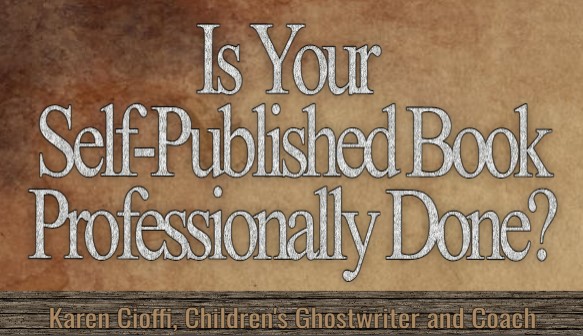I want to start by saying that there are a lot of self-published (SP) children’s books that are as good as or exceed traditionally published books. The authors who produce these books take care and do it right. They do everything they should to ensure their book meets the mark. But… There are an awful lot of SP books out there that are way off the mark. So, what about your book? Is it professionally done? Is it a book that you’re proud to be author of? If you answered NO to any of the above questions, how can you improve your books? The top five ways to make sure your children’s book is publishable and marketable; in other words, professionally done. 1. Research. If you’re new or newish to the children’s writing arena, study other children’s books in the genre you want to write. Go deep into these books. Pay attention to everything from story structure, character development, pacing, grammar, punctuation, character and story arcs, sentence structure… everything. For those reading this and thinking you can hire a CHEAP editor to take care of all that stuff, that’s a HUGE mistake. I just read a manuscript from an author who had it edited before sending it to me. Even the quotation marks for dialogue were wrong - this is basic stuff. If the author had taken the time to research-study books, she would have known this. 2. Don’t think you’re good to go right out of the box. No children’s story is good-to-go right out of the box. It takes revisions to make it shine. Your first draft is just that, a first draft. That’s why they’re numbered. Pay attention to structure, organization, consistency, focus, clarity, and flow. Give it a couple of drafts before deciding you can move on to the next phase. 3. Have your children’s manuscript professionally edited. If you want a book that looks and reads professional, you need to get it professionally edited. Keep in mind the author I mentioned in Number 1 above. I’d never seen such a poorly written manuscript and she had it edited. Before looking for an editor, learn the basics and get your manuscript into the best shape you can. This will possibly help reduce the editor’s fee. The more an editor has to do, the more you’ll be charged. Once you’re at the best you can do stage, research editors. Look for testimonials and samples of the editor’s work. You might even ask for the editor to edit a paragraph or two of your manuscript. I’ve done this for potential clients, but I’m not sure all editors will. You can also ask around for recommendations. A good way to do this is to join the Society of Children’s Writers and Illustrators (SCBWI). There are a lot of experienced writers who are happy to help. I'm an editor too. :) Warning: Once you have your story edited by a professional children’s editor, don’t let a self-publishing service re-edit it. I’ve seen these services make a mess out of a professionally edited story. Note: It’s a good idea for the editor to work in the genre you’re writing. 4. You’ll need some additional pages. Front matter: -Title page -Copyright page -Dedication page (optional) Back matter (optional): -Author page -Glossary -Reading comprehension page -More information page/s 5. Hire a good illustrator. Picture books rely heavily on the illustrations. They help tell the story. Chapter books also need illustrations as this reader may still use the illustrations to help grasp the story. This is why you need a good illustrator, one who knows what he’s doing. Check out their portfolio. You might ask for a sample, although, not all illustrators will do this. And it's not a good idea to hire an illustrator based on sketches. I worked with one who had great sketches, but the colored illustrations were boring. You also want an illustrator who is creative enough to see what you can’t, and one who can create a grabbing cover. The cover is the number one contributing factor that motivates a reader to buy your book. It's a good idea to take advantage of it by having it done right. There are better places to try to save money. At a loss to find an illustrator? You can use SCBWI to find one. I provide my clients with a list of illustrators that I’ve worked with or my clients have. Illustration tips: -Be sure you will own the illustrations once you pay for them. -Be sure the illustrator will do revisions. -Check each illustration for page accuracy and consistency throughout. -Hire an illustrator who does the text inlay. -Check the text inlay for accuracy. I’ve seen some terrible mistakes in this area. -It’s important to get the individual illustrations even if the illustrator provides a PDF of the entire book. -Review the finished work carefully before handing it off to a formatter/designer, or a self-publishing service. Hope this helps you create a professional children’s book that you’ll be proud to be author of.
I’m a working children’s ghostwriter, rewriter, and coach. I can help turn your story into a book you’ll be proud to be author of, one that’s publishable and marketable. Or, if you’d rather do-it-yourself, check out my book, How to Write a Children’s Fiction Book. I've even got you covered if your manuscript is already done but you need help getting it self-published? Check out Writers on the Move Publishing. You can contact me at: kcioffiventrice@gmail.com. Or, you can give me a call at 834---347---6700. (Please leave a message - I'll get back to you as soon as I can.)



Karen,
Thank you for this detailed and excellent article to help others.
Terry
author of Book Proposals That $ell, 21 Secrets To Speed Your Success (Revised Edition) [Follow the Link for a FREE copy]
Thank you for stopping by, Terry! I’ve seen so many poorly self-published books that I needed to address it.